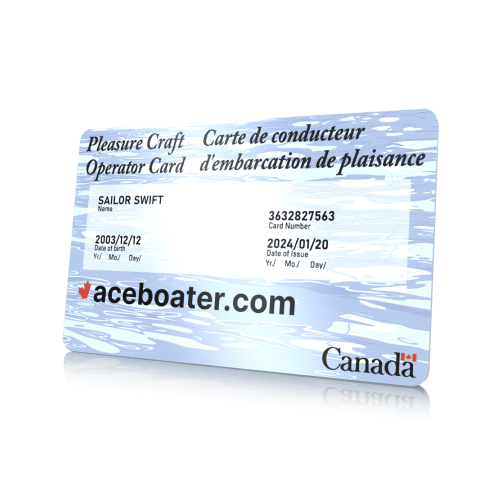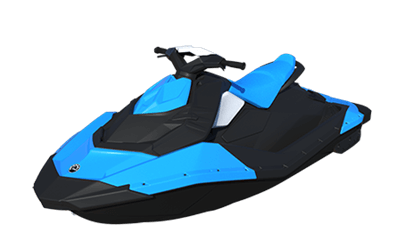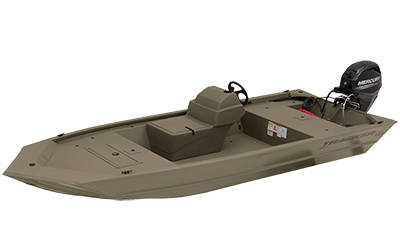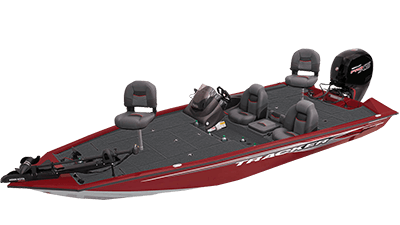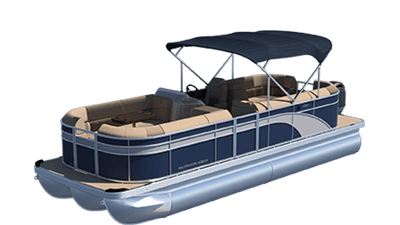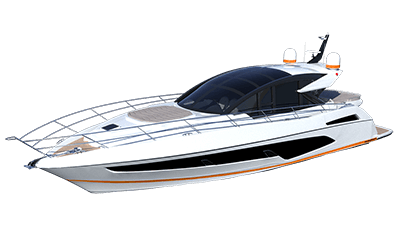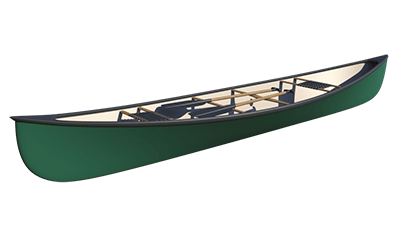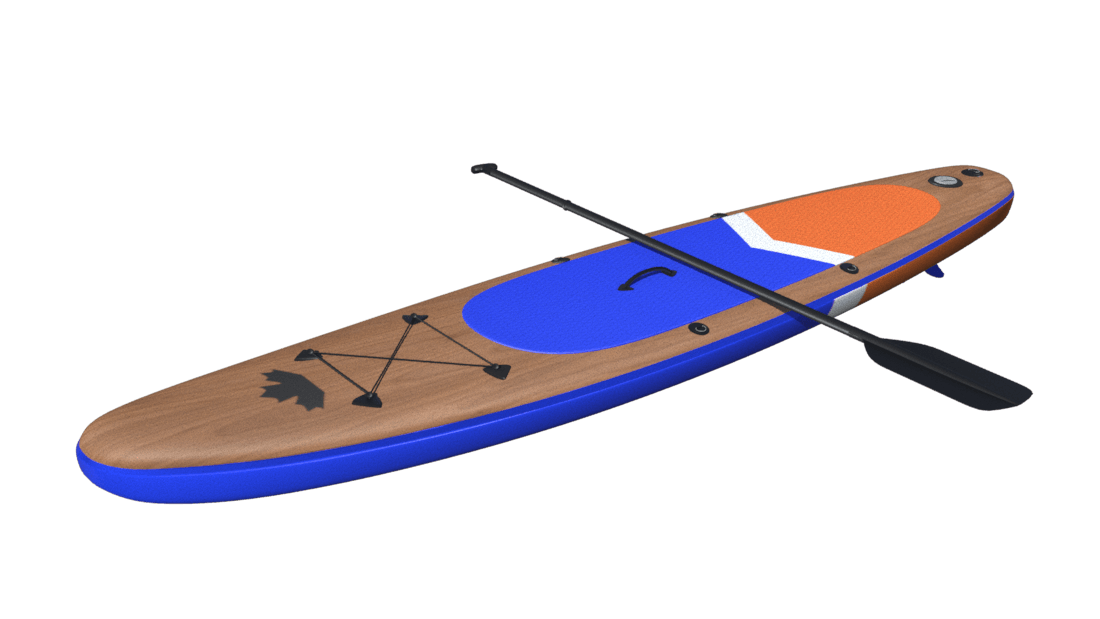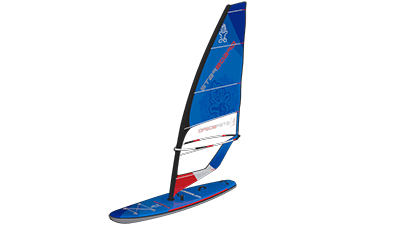What safety equipment is required on a boat in Canada? Marine Safety Equipment requirements - Transport Canada - Ontario - BC - Alberta...
Ensuring your boat is equipped with the proper safety gear is essential for a safe journey. It's not enough to simply have these items on board; they must be in good condition and readily available during emergencies.
What determines the minimum safety equipment requirements for a pleasure craft?
The specific safety equipment needed will depend on the type and size of your boat.

Discover the essential of boat safety equipment that each type of boat must carry on board to comply with the Small Vessel Regulations (part of the Canada Shipping Act, 2001):
-
Personal Watercraft (PWC)
-
Sail and Power Boats up to 6 m (19'8")
-
Canoes, kayaks, rowboats and rowing shells
-
Sail and Power Boats over 6 m and up to 9 m (19'8''- 29'6'')
-
Sail and Power Boats over 9 m and up to 12 m (29'6"- 39'4")
-
Sail and Power boats over 12 m and up to 24 m (39'4"- 78'9")
-
Sail and Power Boats over 24 m (78'9")
-
Paddleboards, paddleboats, watercycles, sealed-hull and sit-on-top kayaks
-
Sailboards and Kiteboards
Make sure you have the necessary safety equipment on board, always in excellent working condition, carefully maintained, and easily accessible in case of emergencies.
-
- approved Personal Flotation Device for each person on board
- pleasure craft operator card
- sound-signaling device
- watertight flashlight or three pyrotechnic distress signals, not more than one of which is a smoke signal
- magnetic compass (not necessary when in view of navigation markers)
- Navigation lights (not required in daylight and good visibility) If one person on board a personal watercraft is not wearing a lifejacket or a PFD of an appropriate size, you must add the following equipment:
-
- buoyant heaving line at least 15m (49’3”) long
- reboarding device (only required if reboarding means climbing a vertical height of more than 0.5 m (1’8”) from the water).
- manual propelling device or an anchor and at least 15 m (49’3”) of cable, rope or chain in any combination
- bailer or manual bilge pump or bilge-pumping equipment
- radar reflector (not necessary for typical daytime and near-shore activities).
- fire extinguisher (5 BC)
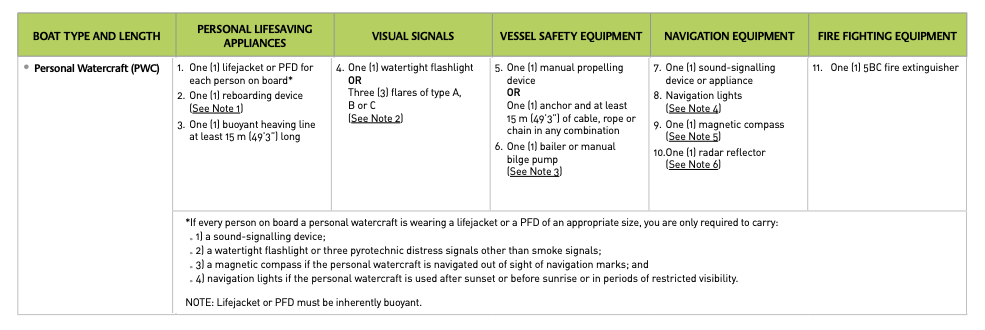
-
- personal Flotation Device (PFD) or Lifejacket for each person on board
- pleasure craft operator card
-
- Buoyant heaving line at least than 15 m (49’3”) long
- reboarding device (only required if reboarding means climbing a vertical height of more than 0.5 m (1’8”) from the water).
If the boat is equipped with a motor, add the following equipments:
-
- watertight flashlight or three pyrotechnic distress signals, not more than one of which is a smoke signal. Note: Flares are not required for a pleasure craft that: Is operating on a river, canal or lake in which it can never be more than one (1) nautical mile (1.852 km) from shore; or has no sleeping quarters and is engaged in an official competition or in final preparation for an official competition.
- manual propelling device or anchor and at least 15 m (49’3”) of cable, rope or chain in any combination
-
- bailer or a manual water pump
- sound-signaling appliance or a sound-signaling device
- navigation lights (not required in daylight and good visibility)
- magnetic compass (not necessary when in view of navigation markers)
- fire extinguisher (5 BC) (if the pleasure craft is equipped with an inboard engine, a fixed fuel tank of any size, or a fuel-burning cooking, heating or refrigeration appliance)
- radar reflector (not necessary for typical daytime and near-shore activities).

-
- Personal flotation Device or Lifejacket
- pleasure craft operator card
- of appropriate size for each person on board
- buoyant heaving line at least than 15 m (49’3”) long or lifebuoy attached to a buoyant line at least 15 m (49’3”) long
- reboarding device Note: A reboarding device is only required if the vertical height that must be climbed to reboard the pleasure craft from the water is over 0.5 m (1’8”).
- watertight flashlight
- Six pyrotechnic distress signals, not more than two of which are smoke signals or At least three pyrotechnic distress signals, not more than one of which is a smoke signal, if there is also a means of two way electronic communications on board (i.e., cell phones, satellite phones, VHF, 406 MHz personal locater beacons, or EPIRB) Note: Flares are not required for a pleasure craft that: Is operating on a river, canal or lake in which it can never be more than one (1) nautical mile (1.852 km) from shore; or Has no sleeping quarters and is engaged in an official competition or in final preparation for an official competition.
- manual propelling device or One anchor and at least 15 m (49’3”) of cable, rope or chain in any combination
- bailer or one manual bilge pump Note: A bailer or manual water pump is not required for a pleasure craft that cannot hold enough water to make it capsize or a pleasure craft that has watertight compartments that are sealed and not readily accessible.
- sound-signalling device or appliance
- navigation lights that meets the requirements set out in the Collision Regulations. Navigation lights are only required if the pleasure craft is operated after sunset, before sunrise, or in periods of restricted visibility (fog, falling snow, etc.). Sailing vessels less than 7 m in length can meet this requirement with a watertight flashlight
- magnetic compass A magnetic compass is not required if the pleasure craft is 8 m (26’3”) or less and is operated within sight of sea marks (navigation marks).
- fire extinguisher (5BC) if the pleasure craft is equipped with a motor
- 5BC fire extinguisher if the pleasure craft is equipped with a fuel-burning cooking, heating or refrigeration appliance
- radar reflector is required under certain conditions

-
- Personal Flotation Device (PFD) or Lifejacket of appropriate size for each person on board
- pleasure craft operator card
- buoyant heaving line at least than 15 m (49’3”) long
-
- lifebuoy attached to a buoyant line at least 15 m (49’3”) long
- reboarding device Note: A reboarding device is only required if the vertical height that must be climbed to reboard the pleasure craft from the water is over 0.5 m (1’8”).
- watertight flashlight
- twelve pyrotechnic distress signals, not more than six of which are smoke signals or at least six pyrotechnic distress signals, not more than three of which are smoke signals, if there is also a means of two way electronic communications on board (i.e., cell phones, satellite phones, VHF, 406 MHz personal locater beacons, or EPIRB). Note: Flares are not required for a pleasure craft that: Is operating on a river, canal or lake in which it can never be more than one (1) nautical mile (1.852 km) from shore; or Has no sleeping quarters and is engaged in an official competition or in final preparation for an official competition.
- anchor and at least 30 m (98’5”) of cable, rope or chain in any combination
- manual bilge pump or bilge-pumping arrangements Note: A bailer or manual bilge pump is not required for a pleasure craft that cannot hold enough water to make it capsize or a pleasure craft that has watertight compartments that are sealed and not readily accessible.
- sound-signalling appliance or a sound-signalling device
- navigation lights
- magnetic compass
- 10BC fire extinguisher if the pleasure craft is equipped with motor and one 10BC fire extinguisher if the pleasure craft is equipped with a fuel-burning cooking, heating or refrigeration appliance
- radar reflector is required under certain conditions.

-
- personal flotation device or lifejacket of appropriate size for each person on board
- pleasure craft operator card
-
- buoyant heaving line at least than 15 m (49’3”) long
- lifebuoy equipped with a self-igniting light or attached to a buoyant line at least 15 m (49’3”) long
- reboarding device Note: A reboarding device is only required if the vertical height that must be climbed to reboard the pleasure craft from the water is over 0.5 m (1’8”).
- watertight flashlight
- Twelve pyrotechnic distress signals, not more than six of which are smoke signals. or at least six pyrotechnic distress signals, not more than three of which are smoke signals, if there is also a means of two way electronic communications on board (i.e., cell phones, satellite phones, VHF, 406 MHz personal locater beacons, or EPIRB). Note: Flares are not required for a pleasure craft that: Is operating on a river, canal or lake in which it can never be more than one (1) nautical mile (1.852 km) from shore; or Has no sleeping quarters and is engaged in an official competition or in final preparation for an official competition.
- anchor and at least 50 m (164’1”) of cable, rope or chain in any combination
- bilge-pumping arrangements
- sound-signalling appliances Note: Pleasure craft over 20 m (65’7”) in length require a whistle (horn), and a fitted bell.
- navigation lights
- magnetic compass
- 10BC fire extinguisher at all of the following locations: at each access to any space where a fuel-burning cooking, heating or refrigerating appliance is fitted; at the entrance to any accommodation space; and at the entrance to the machinery space.
- axe
- 2 buckets Note: Transport Canada recommends that each bucket have a capacity of at least 10 litres.
- radar reflector is required under certain conditions.

-
- flotation device or lifejacket for each person on board
- pleasure craft operator card
-
- buoyant heaving line at least than 30 m (98’5”) long
- 2 SOLAS lifebuoy, of which: one is attached to a buoyant line at least 30 m (98 ’5”) long; and one is equipped with a self-igniting light
- lifting harness with appropriate rigging
- reboarding device Note: A reboarding device is only required if the vertical height that must be climbed to reboard the pleasure craft from the water is over 0.5 m (1’8”).
- watertight flashlight
- 12 pyrotechnic distress signals, not more than six of which are smoke signals or at least six pyrotechnic distress signals, not more than three of which are smoke signals, if there is also a means of two way electronic communications on board (i.e., cell phones, satellite phones, VHF, 406 MHz personal locater beacons, or EPIRB). Note: flares are not required for a pleasure craft that: Is operating on a river, canal or lake in which it can never be more than one (1) nautical mile (1.852 km) from shore; or has no sleeping quarters and is engaged in an official competition or in final preparation for an official competition.
- anchor and at least 50 m (164’1”) of cable, rope or chain in any combination
- Bilge-pumping arrangements
- sound-signalling appliances Note: Pleasure craft over 20 m (65’7”) in length require a whistle (horn), and a fitted bell.
- navigation lights
- magnetic compass
- 10BC fire extinguisher at all of the following locations: at each access to any space where a fuel-burning cooking, heating or refrigerating appliance is fitted; at the entrance to any accommodation space; and at the entrance to the machinery space.
- power-driven fire pump located outside the machinery space, with one fire hose and nozzle that can direct water into any part of the boat
- 2 axes
- 4 buckets Note: Transport Canada recommends that each bucket have a capacity of at least 10 litres.
- radar reflector is required under certain conditions
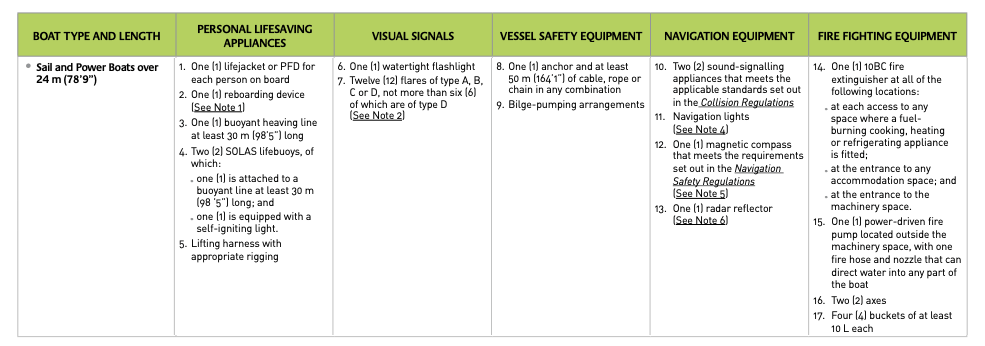
-
- personal Flotation Device for each person on board
- buoyant heaving line at least 15m (49’3”) long
-
- reboarding device Note: A reboarding device is only required if the vertical height that must be climbed to reboard the pleasure craft from the water is over 0.5 m (1’8”).
-
- bailer or manual bilge pump or bilge-pumping equipment Note: A bailer or manual bilge pump is not required for a pleasure craft that will not hold enough water to make it capsize, or a pleasure craft that has watertight compartments that are sealed and not readily accessible.
- sound-signalling appliance or sound-signalling device
- navigation lights Note:Navigation lights are only required if the pleasure craft is operated after sunset, before sunrise, or in periods of restricted visibility (fog, falling snow, etc.). For a human-powered vessel, this requirement can be met with a watertight flashlight.
- magnetic compass Note: A magnetic compass is not required if the pleasure craft is 8 m (26’3”) or less and is operated within sight of seamarks (navigation marks).
- radar reflector is required under certain conditions
If the human-powered pleasure craft is more than 6 m long, you must add:
-
- watertight flashlight
- 6 pyrotechnic distress signals, not more than two of which are smoke signals or at least three pyrotechnic distress signals, not more than one of which is a smoke signal, if there is also a means of two way electronic communications on board (i.e., cell phones, satellite phones, VHF, 406 MHz personal locater beacons, or EPIRB). Note: Flares are not required for a pleasure craft that: is operating on a river, canal or lake in which it can never be more than one (1) nautical mile (1.852 km) from shore; or has no sleeping quarters and is engaged in an official competition, or in final preparation for an official competition.

If everyone on board is wearing a lifejacket or a PFDof appropriate size, only the following equipment is required on board:
-
- sound-signaling device or appliance,
- watertight flashlight (only required if the boat is operated after sunset, before sunrise or in periods of restricted visibility (fog, falling snow, etc).
If someone on board is not wearing a lifejacket or a PFD of appropriate size, you must add the following equipment:
-
- Personal Flotation Device for each person on board
- buoyant heaving line at least 15m (49’3”) long
- reboarding device Note: A reboarding device is only required if the vertical height that must be climbed to reboard the pleasure craft from the water is over 0.5 m (1’8”).
- bailer or manual bilge pump or bilge-pumping equipment Note: A bailer or manual bilge pump is not required for a pleasure craft that will not hold enough water to make it capsize, or a pleasure craft that has watertight compartments that are sealed and not readily accessible.
- sound-signaling appliance or sound-signaling device
- navigation lights Note: Navigation lights are only required if the pleasure craft is operated after sunset, before sunrise, or in periods of restricted visibility (fog, falling snow, etc.). For a human-powered vessel, this requirement can be met with a watertight flashlight.
- magnetic compass Note: A magnetic compass is not required if the pleasure craft is 8 m (26’3”) or less and is operated within sight of seamarks (navigation marks).
- radar reflector is required under certain conditions
If the human-powered pleasure craft is more than 6 m long, you must add:
-
- watertight flashlight
- 6 pyrotechnic distress signals, not more than two of which are smoke signals or at least three pyrotechnic distress signals, not more than one of which is a smoke signal, if there is also a means of two way electronic communications on board (i.e., cell phones, satellite phones, VHF, 406 MHz personal locater beacons, or EPIRB). Note: Flares are not required for a pleasure craft that: is operating on a river, canal or lake in which it can never be more than one (1) nautical mile (1.852 km) from shore; or has no sleeping quarters and is engaged in an official competition, or in final preparation for an official competition.

If the operator of a sailboard or kiteboard is wearing a lifejacket or PFD of appropriate size, only the following equipment is required on board:
-
- sound-signaling device
- watertight flashlight If the paddleboat, watercycle or kayak is operated after sunset, before sunrise, or in periods of restricted visibility (fog, falling snow, etc.).
If the operator of a sailboard or kiteboard is not wearing a lifejacket or PFD of appropriate size, the following equipment is required on board:
-
- Personal Flotation Device for each person on board Note: A personal flotation device or lifejacket kept on board a human-powered pleasure craft, operated in whitewater must be inherently buoyant.
- buoyant heaving line at least 15m (49’3”) long
- reboarding device Note: A reboarding device is only required if the vertical height that must be climbed to reboard the pleasure craft from the water is over 0.5 m (1’8”).
- bailer or manual bilge pump or bilge-pumping equipment Note: A bailer or manual bilge pump is not required for a pleasure craft that will not hold enough water to make it capsize, or a pleasure craft that has watertight compartments that are sealed and not readily accessible.
- sound-signalling appliance or sound-signalling device
- Navigation lights Note:Navigation lights are only required if the pleasure craft is operated after sunset, before sunrise, or in periods of restricted visibility (fog, falling snow, etc.). For a human-powered vessel, this requirement can be met with a watertight flashlight.
- magnetic compass Note: A magnetic compass is not required if the pleasure craft is 8 m (26’3”) or less and is operated within sight of seamarks (navigation marks).
- radar reflector is required under certain conditions

Now that you have an idea of the different safety equipment you need on your boat, come discover with us, all the other aspects of boating with our online boating safety course and obtain your Canadian boating license (PCOC).
These rules apply to: Ontario, Alberta, British Columbia, Quebec, Newfoundland, Nova Scotia, New Brunswick, Saskatchewan, Manitoba, Prince Edward Island and Northwest Territories.
